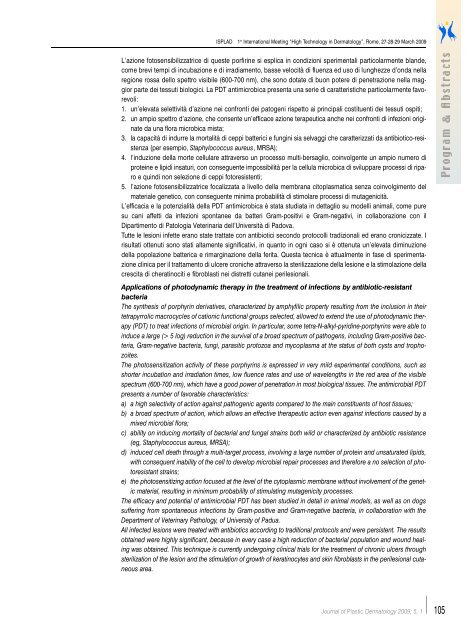Vol. 5, n. 1, January-March 2009 1th International ... - Salute per tutti
Vol. 5, n. 1, January-March 2009 1th International ... - Salute per tutti
Vol. 5, n. 1, January-March 2009 1th International ... - Salute per tutti
Create successful ePaper yourself
Turn your PDF publications into a flip-book with our unique Google optimized e-Paper software.
ISPLAD 1 st <strong>International</strong> Meeting “High Technology in Dermatology”, Rome, 27-28-29 <strong>March</strong> <strong>2009</strong><br />
L’azione fotosensibilizzatrice di queste porfirine si esplica in condizioni s<strong>per</strong>imentali particolarmente blande,<br />
come brevi tempi di incubazione e di irradiamento, basse velocità di fluenza ed uso di lunghezze d’onda nella<br />
regione rossa dello spettro visibile (600-700 nm), che sono dotate di buon potere di penetrazione nella maggior<br />
parte dei tessuti biologici. La PDT antimicrobica presenta una serie di caratteristiche particolarmente favor<br />
e v o l i :<br />
1. un’elevata selettività d’azione nei confronti dei patogeni rispetto ai principali costituenti dei tessuti ospiti;<br />
2. un ampio spettro d’azione, che consente un’efficace azione terapeutica anche nei confronti di infezioni originate<br />
da una flora microbica mista;<br />
3. la capacità di indurre la mortalità di ceppi batterici e fungini sia selvaggi che caratterizzati da antibiotico-resistenza<br />
(<strong>per</strong> esempio, Staphylococcus aureus, MRSA);<br />
4. l’induzione della morte cellulare attraverso un processo multi-bersaglio, coinvolgente un ampio numero di<br />
proteine e lipidi insaturi, con conseguente impossibilità <strong>per</strong> la cellula microbica di sviluppare processi di riparo<br />
e quindi non selezione di ceppi fotoresistenti;<br />
5. l’azione fotosensibilizzatrice focalizzata a livello della membrana citoplasmatica senza coinvolgimento del<br />
materiale genetico, con conseguente minima probabilità di stimolare processi di mutagenicità.<br />
L’efficacia e la potenzialità della PDT antimicrobica è stata studiata in dettaglio su modelli animali, come pure<br />
su cani affetti da infezioni spontanee da batteri Gram-positivi e Gram-negativi, in collaborazione con il<br />
Dipartimento di Patologia Veterinaria dell’Università di Padova.<br />
Tutte le lesioni infette erano state trattate con antibiotici secondo protocolli tradizionali ed erano cronicizzate. I<br />
risultati ottenuti sono stati altamente significativi, in quanto in ogni caso si è ottenuta un’elevata diminuzione<br />
della popolazione batterica e rimarginazione della ferita. Questa tecnica è attualmente in fase di s<strong>per</strong>imentazione<br />
clinica <strong>per</strong> il trattamento di ulcere croniche attraverso la sterilizzazione della lesione e la stimolazione della<br />
crescita di cheratinociti e fibroblasti nei distretti cutanei <strong>per</strong>ilesionali.<br />
Applications of photodynamic therapy in the treatment of infections by antibiotic-resistant<br />
b a c t e r i a<br />
The synthesis of porphyrin derivatives, characterized by amphyfilic pro<strong>per</strong>ty resulting from the inclusion in their<br />
tetrapyrrolic macrocycles of cationic functional groups selected, allowed to extend the use of photodynamic therapy<br />
(PDT) to treat infections of microbial origin. In particular, some tetra-N-alkyl-pyridine-porphyrins were able to<br />
induce a large (> 5 log) reduction in the survival of a broad spectrum of pathogens, including Gram-positive bacteria,<br />
Gram-negative bacteria, fungi, parasitic protozoa and mycoplasma at the status of both cysts and trophozoites.<br />
The photosensitization activity of these porphyrins is expressed in very mild ex<strong>per</strong>imental conditions, such as<br />
shorter incubation and irradiation times, low fluence rates and use of wavelengths in the red area of the visible<br />
spectrum (600-700 nm), which have a good power of penetration in most biological tissues. The antimicrobial PDT<br />
presents a number of favorable characteristics:<br />
a) a high selectivity of action against pathogenic agents compared to the main constituents of host tissues;<br />
b) a broad spectrum of action, which allows an effective therapeutic action even against infections caused by a<br />
mixed microbial flora;<br />
c) ability on inducing mortality of bacterial and fungal strains both wild or characterized by antibiotic resistance<br />
(eg, Staphylococcus aureus, MRSA);<br />
d) induced cell death through a multi-target process, involving a large number of protein and unsaturated lipids,<br />
with consequent inability of the cell to develop microbial repair processes and therefore a no selection of photoresistant<br />
strains;<br />
e) the photosensitizing action focused at the level of the cytoplasmic membrane without involvement of the genetic<br />
material, resulting in minimum probability of stimulating mutagenicity processes.<br />
The efficacy and potential of antimicrobial PDT has been studied in detail in animal models, as well as on dogs<br />
suffering from spontaneous infections by Gram-positive and Gram-negative bacteria, in collaboration with the<br />
Department of Veterinary Pathology, of University of Padua.<br />
All infected lesions were treated with antibiotics according to traditional protocols and were <strong>per</strong>sistent. The results<br />
obtained were highly significant, because in every case a high reduction of bacterial population and wound healing<br />
was obtained. This technique is currently undergoing clinical trials for the treatment of chronic ulcers through<br />
sterilization of the lesion and the stimulation of growth of keratinocytes and skin fibroblasts in the <strong>per</strong>ilesional cutaneous<br />
area.<br />
Journal of Plastic Dermatology <strong>2009</strong>; 5, 1<br />
105

















